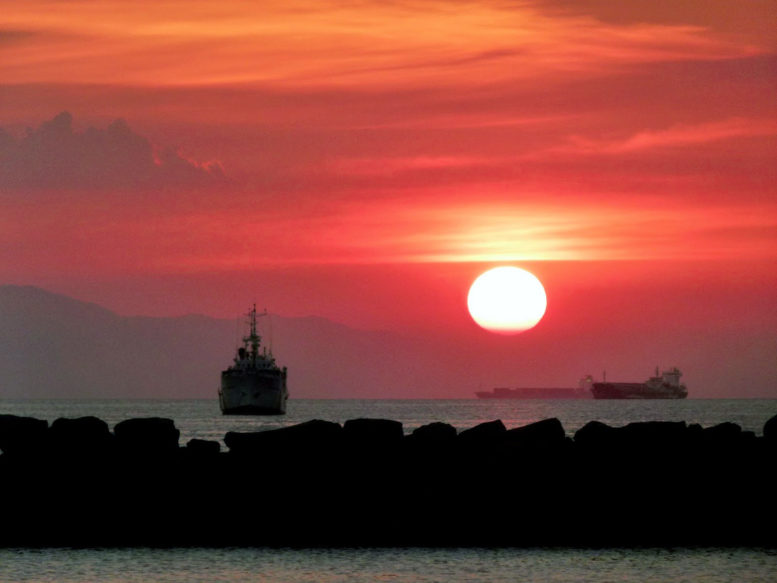What once was a beacon of loveliness that would first catch your eye with its glorious sunset is now a down drum of uncleanliness, an eyesore of unseemliness that casts a sty. This is not the result of a mere slip-up but rather continuous discharge of toxic oil, industrial effluents, agricultural runoffs, untreated wastewater, and city garbage over the decades. The source of pollution is both sea-based and land-based. Manila Bay is no longer the reservoir of clear blue water of Post World War II era. It is now awash with oil and grime, choked by seepage from corporate industries, ocean-going vessels such as oil tankers and very large container carriers. Quite often, lifeless sea creatures are washed ashore and their immediate cause of death has been directly attributed to the intake of toxic oil residue and plastic trash that have been polluting the bay waters and shoreline. “Pollutants which come from both land and sea are responsible for grave effects on marine life because they interfere with the functions of marine ecosystem,” said ENS Grace Idos, Chief of Staff, Marine Environmental Research and Development Center (MERDC) of the Marine Environmental Protection Command (MEPCOM), which is part of the Philippine Coast Guard. ENS Grace Idos added that among the many contributors to the pollution in the bay are oil spills from ships, vessels, industries along waterways, and owners of land vehicles that throw their used oil in creeks, canals, and drainage every time they change engine oil. But the most hazardous to human and marine life is untreated wastewater dumped into the bay.
With the continuous increase in population and industrialization, Manila Bay has been facing several issues arising from conflicts in the use of the bay and its natural resources, continued decline in the quality of the bay water and sediment, and rapid destruction of marine habitats. The Pampanga River contributes 49% of net fresh water inflow into the bay (Jacinto et al., 2000a). But the northern part of the bay receives volcanic lahar discharges; the western coast receives watershed discharges from Bataan; and the eastern side receives rural and urban river flow from the coastal towns of Cavite and Bulacan, in addition to more polluted runoffs from the rivers of Metro-Manila, particularly Pasig River, which contributes 21% of net freshwater flows. The other rivers together contribute 26% of net freshwater. The remaining 4% comes from precipitation into Manila Bay [I. Velazquez et al (2006). Biophysical Environment of Manila Bay: Then and Now. The Environment in Asia Pacific Harbours, pp. 293-307].
Manila Bay is located in western Luzon, bounded by Cavite and Metro-Manila cities on the east, Bulacan and Pampanga on the north, and Bataan on the west and northwest. The southern part of the bay opens to the West Philippine Sea. Garbage emanating from the Pasig River pollutes our waterways, and most of the garbage that eventually surfaces in Manila Bay comes from these provinces, driven by the river current during high tide and storms. Wastewater plants in these provinces must meet treatment standards. Historically, untreated wastewater was discharged into Manila Bay from dumpsites like Navotas (Pier 18) and Cavite (World Bank Environment Monitor, 2003). Even to-date, garbage and wastewater treatment, particularly in Cavite and Bulacan, must be strictly complied with simply because of their immediate effects on the waters of Manila Bay. But a lot of effluents from logging, mining, pharmaceutical industries, and agricultural runoffs also come from provinces as far north as Ilocos and Zambales.
Last January, the Philippine Coast Guard Auxiliary undertook a one-day clean up drive along the shoreline of Manila Bay. A whole truckload of trash was hauled from a portion of the shoreline. In the same month, the Philippine and Norwegian governments signed a Memorandum of Understanding (MOU) for a sustainable development and management master plan for Manila Bay. They agreed to draft the Manila Bay Sustainable Development Master Plan, which would guide future decisions on projects such as coastal protection, solid waste and water resources management, transport, reclamation, and rehabilitation of the Pasig River.
Coastal protection in Manila Bay with over 190 km of coastline to cover is no easy feat. The Metro-Manila cities and surrounding provinces of the bay must pluck up Political Will to step up and help design the Sustainable Development Plan to save Manila Bay’s water, shoreline, indigenous 50 fish species, and mangroves. The 54K hectares of Nilad mangrove forests are almost gone. Most importantly, the design of low-cost sewage treatment plants must be explored in light of tight budget resources of the LGUs.
Until the master plan is finished and officially unveiled, we need more local community clean up efforts, in tandem with corporate giants that produced the majority of toxic effluents and plastic trash in the bay, not on a one-time basis but on a comprehensive clean up effort all year round. Let’s do this for the long haul. We could allot 10 km of shoreline per city on an “adoption” basis. Until its environs are healthy, clean and beautiful once again only then can we, and the next generations to come, truly savor the fresh bay breezes, local seafood catch of the day, and the magnificent peach sunsets along the boardwalk of historical Manila Bay.

Thank you for sharing this excellent study of the root causes if the current Poll ituon if Manila Bay. The Study exposes the fact that Manila Bay’s current condition is a stark reflection of the State’s historical negligence in the care and protection of our natural environment and our waterways which constitute the life blood of rhe nation.
Thank you for bringing attention to this critical issue which affects everyone.